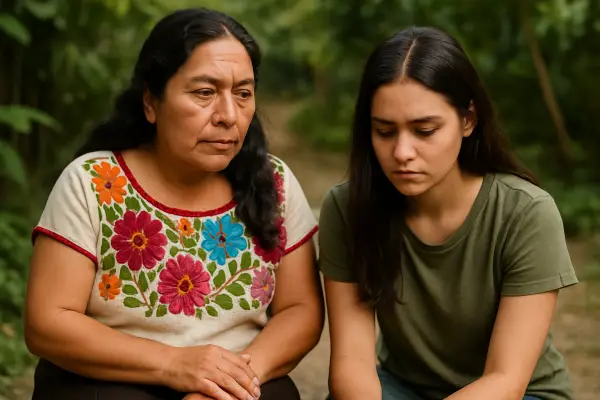Can a curandera cure depression? This question emerges from deep places of suffering, where conventional approaches may feel incomplete or disconnected from cultural roots. Many people seeking healing wonder whether ancient wisdom can address modern struggles with mental health.
María del Pilar Fernández has witnessed countless individuals torn between worlds—honoring ancestral healing traditions while navigating contemporary mental health challenges. Through her practice of curanderismo, she believes in addressing depression not as an isolated condition, but as a manifestation of spiritual, emotional, and energetic imbalances that require holistic attention.
Can a curandera cure depression?
Curanderismo can provide significant support for depression through holistic healing approaches that address body, mind, and spirit simultaneously. However, curanderas work alongside, not in place of, licensed mental health professionals and medical care.

Research conducted in Mexican communities has demonstrated that curanderismo can be as, and sometimes more, effective as psychotherapy for a spectrum of mental health issues—including anxiety, depression, and PTSD. This effectiveness stems from curanderismo’s comprehensive approach to healing, which recognizes that depression often involves spiritual wounds and energetic imbalances alongside biochemical factors.
Understanding depression through curanderismo
Traditional curanderismo views depression through the lens of soul fragmentation and spiritual disconnection. A traumatic event, for instance, can fragment the soul, leaving a piece behind at the time and place of crisis. This creates excruciating soul wounds, and many illnesses Grace treats stem from such pain. Depression, in this understanding, may result from parts of the soul becoming lost or disconnected during times of trauma, grief, or overwhelming life circumstances.
Curanderas recognize several spiritual conditions that manifest as depressive symptoms. Susto, or soul fright, occurs when traumatic experiences cause soul loss, leaving individuals feeling empty, disconnected, and unable to fully engage with life. Mal de ojo (evil eye) can create feelings of worthlessness and despair. Tristeza represents deep sadness that has settled into the spirit, often following significant losses or prolonged stress.
Traditional healing approaches for depression
Curanderas employ multiple healing modalities to address depression’s spiritual, emotional, and energetic aspects:
Limpias espirituales (spiritual cleansings) form the foundation of treatment. These ceremonies use sacred herbs like copal, ruda, and estafiate to cleanse negative energy and restore spiritual balance. Trained traditional healers will share their knowledge of cleansings from different cultures such as spiritual, energetic and Tonalli Cleansing. The limpia creates space for healing by removing energetic blockages that contribute to depressive states.
Platicas (heart-to-heart conversations) provide culturally resonant counseling that honors the client’s worldview and family dynamics. These therapeutic conversations address underlying emotional wounds while incorporating spiritual guidance and ancestral wisdom. The curandera listens deeply to understand how depression connects to the person’s life story, relationships, and spiritual well-being.
Herbal remedies support emotional balance through plant medicines traditionally used for mood disorders. Hierbas like manzanilla (chamomile) calm anxiety, while toronjil (lemon balm) lifts spirits and passiflora (passion flower) eases restlessness. These plants work energetically as well as biochemically to restore harmony.
Retrieval ceremonies address soul loss by calling back fragmented parts of the spirit. Through ritual, prayer, and energetic work, curanderas help clients reclaim lost vitality and wholeness. This process often brings profound emotional release and renewed connection to life force.
The role of community and faith
Curanderismo’s effectiveness in treating depression stems partly from its embedded nature within community and spiritual frameworks. Unlike isolated individual therapy, curandera sessions often involve family members and recognize how depression affects entire family systems. Factors observed to have potential to facilitate healing include psychological reassurance gained through incorporating familiar religious beliefs and paraphernalia and the therapeutic healing property of features of curanderismo practice.
Faith plays a central role in healing, whether through Catholic saints, indigenous deities, or universal spiritual forces. This spiritual dimension provides hope, meaning, and connection to something greater than individual suffering. Prayer, ceremony, and sacred ritual create containers for transformation that purely secular approaches may lack.
Integrating curanderismo with conventional treatment
Modern curanderas recognize the value of integrating traditional healing with contemporary mental health care. It may be used as adjunct therapy in cases of life-threatening illnessnesses. Depression often requires multiple healing approaches—medication may address biochemical imbalances while curanderismo heals spiritual wounds and restores cultural connection.
Successful integration requires open communication between curanderas, clients, and healthcare providers. Some curanderas work directly with therapists and psychiatrists to provide culturally appropriate complementary care. This collaboration honors both scientific understanding of depression and traditional wisdom about spiritual healing.
Effectiveness and limitations
Like in any healthcare field, cures are not guaranteed: the patient (and always in the case of minors, the family) must commit to being an active participant in the healing along with the curandera. Depression’s complexity means that curanderismo, while powerful, cannot guarantee complete healing for every individual.
Traditional healing works best when clients feel cultural resonance with the approach and maintain faith in the process. For those disconnected from indigenous or Latino cultural roots, curanderismo may feel foreign or ineffective. Additionally, severe depression involving suicidal ideation or psychosis requires immediate professional mental health intervention alongside any traditional healing.
Research indicates traditional healing practices among Mexican and Mexican Americans may be as high as 50-75% in some parts of the United States, suggesting widespread recognition of curanderismo’s value. However, currently there are no available well-controlled clinical trials to support these claims, highlighting the need for more rigorous scientific study of traditional healing’s effectiveness.
Contemporary relevance
In our increasingly disconnected world, curanderismo offers healing approaches that many find missing in conventional treatment. The emphasis on spirituality, community, and holistic wellness addresses aspects of depression that medication and talk therapy alone may not reach. For individuals with cultural connections to Latino or indigenous traditions, curanderismo provides healing within familiar spiritual and cultural frameworks.
Depression often involves spiritual crisis—questioning life’s meaning, feeling disconnected from purpose, experiencing existential emptiness. Curanderismo directly addresses these spiritual dimensions through ceremony, prayer, and reconnection to ancestral wisdom and natural cycles.
Disclaimer
Please note that Maria is not a physician, psychologist, or nurse. These culture-specific spiritual healing services are not meant to replace medical or psychological diagnosis and treatment. It is recommended that you see a licensed physician or licensed health care professional for any physical or psychological ailment you may have.
Last spring, a young woman named Paloma came to María’s healing space carrying depression like a heavy rebozo wrapped around her shoulders. She had been in therapy for months following her grandmother’s death, but conventional treatment could not touch the spiritual anguish of feeling disconnected from her ancestral lineage. Through limpias with sacred herbs, ceremonies to honor her grandmother’s spirit, and platicas that wove together grief, cultural identity, and spiritual purpose, Paloma gradually reclaimed her vitality. Six months later, she returned—not as a client, but to learn curandera practices herself, understanding that her depression had been a call toward deeper spiritual connection and service to her community’s healing.
